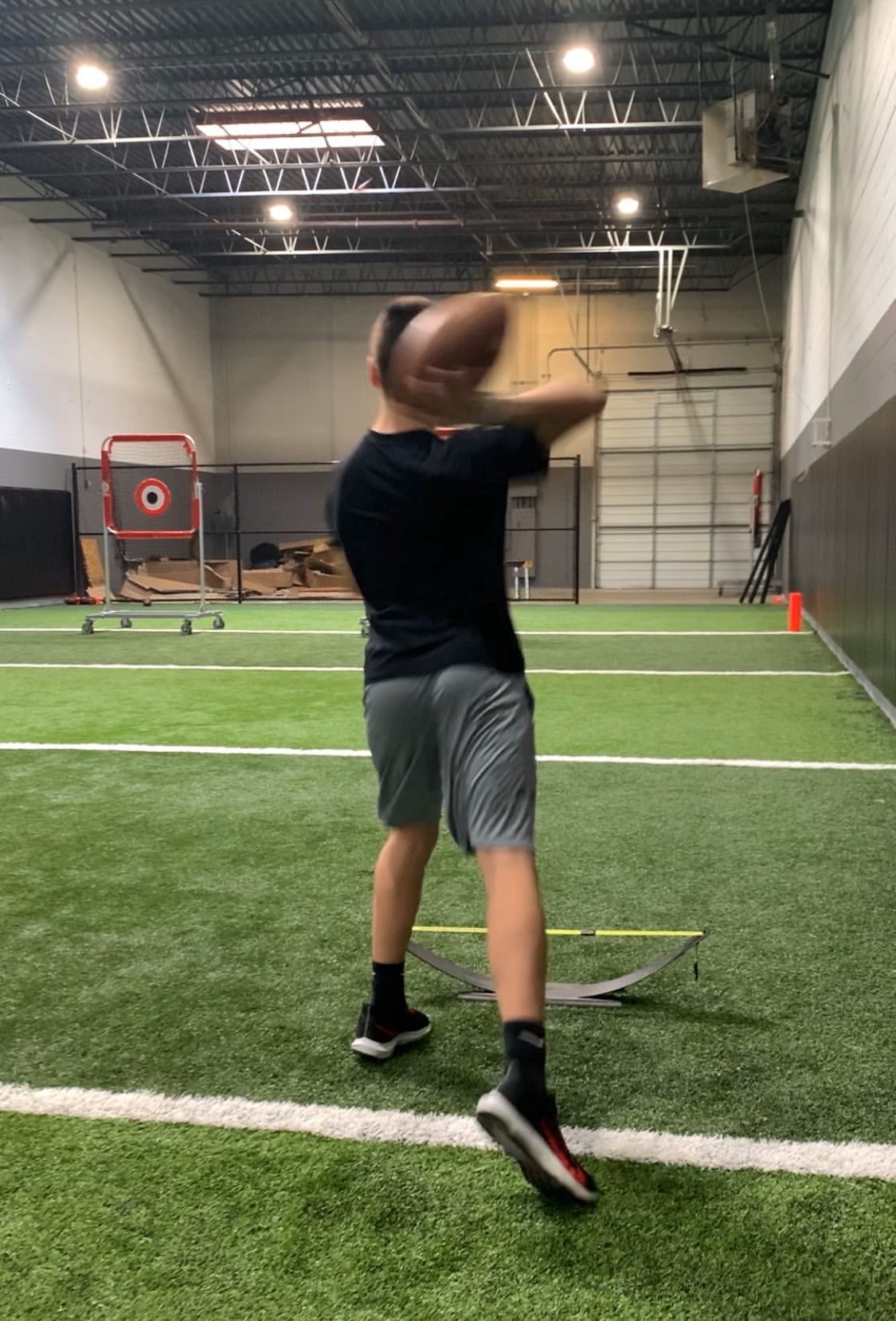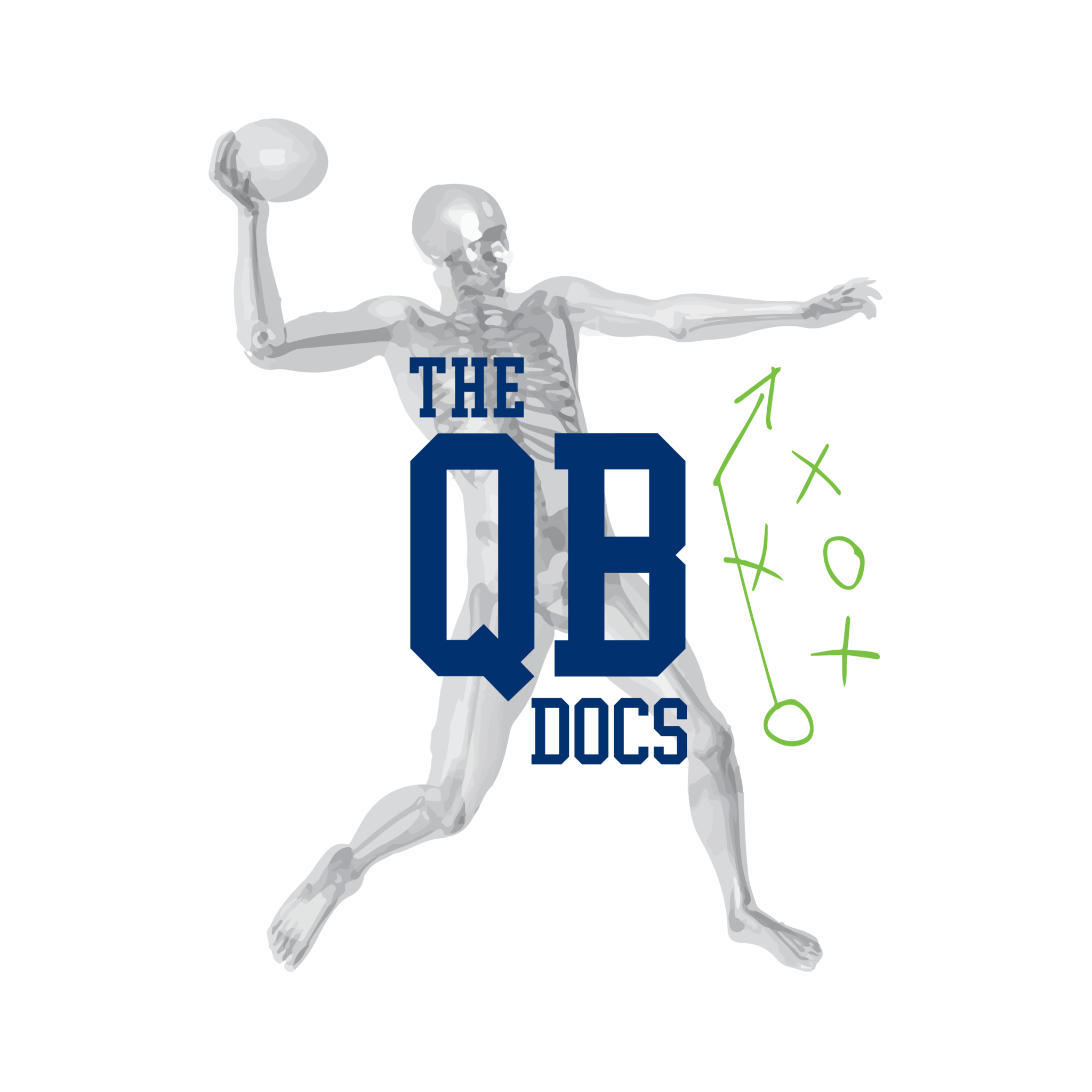Quarterbacks and quarterback coaches all over the country always hear the terms “arm slot”, “arm talent”, and release point all the time when it comes to throwing mechanics. What actually does matter in the upper body mechanics though for a QB? Does it really matter how the quarterback brings the ball back? Is there an ideal area on how far a QB should load the ball back in his motion? We will answer these questions and many more as we break down what actually matters for quarterbacks when it comes to upper body mechanics during the throwing motion!
Arm Slot
There has been a ton of debate on this by numerous quarterback coaches all over the world. Many coaches believe that quarterbacks should initiate the loading phase of the throwing motion with a horizontal elbow as shown below by Carson Wentz.
Often times, quarterbacks are taught to perform the “horizontal L” followed by the “vertical L” in the loading phase to distinguish what the elbow position should look like during the beginning and ending phases of the loading phase of the throwing motion. Is this wrong? No, it’s definitely not wrong. It is just one school of thought and one way of teaching/performing the motion. Are there more ways? Absolutely! Let’s check out another.
This is a picture of possibly the best quarterback to ever play the game and what do you notice with him? Yep, he does not load like the previous quarterback at all. He has had pretty good success in his playing career don’t you think? Brady prefers to start the ball back higher than Wentz and almost bring it straight up instead of loading it lower than Wentz.
Early Loading Phase vs. Late Loading Phase
The key point that I am trying to emphasize here is that the initial loading phase during the motion actually DOES NOT matter for quarterbacks. If a quarterback wants to load the ball low like Wentz or high like Brady, these will both work. The coach coaching the player or the player himself has to find that sweet spot of what works for him. With that said, we wouldn’t want to load any lower than what Wentz does because then there will be some sequencing problems and also increased injury risk. Early loading phase of the motion may not matter, but late loading phase absolutely does. Check this out.
So now these quarterbacks have cocked the ball back fully and are now ready to initiate forward into the acceleration phase of the motion. Nearly every single quarterback out there that has success will get to this position before they accelerate forward. There are some outliers out there. (Phillip Rivers) Instead of focusing on how to load the ball back, quarterbacks and coaches need to be more focused on the position that the QB is trying to get to before initiating the movement forward. There are some commonalities that are crucial as far as position. Let’s go through these.
- 90 degrees of shoulder abduction (90 degree angle between shoulder and torso)
- 90 degrees of elbow flexion
- 90 degrees of shoulder external rotation
- Rib cage down and trunk stable
- Right thoracic rotation
Notice that the wrist position is not talked about here and also notice that there’s other areas of the body that are mentioned that don’t have to do with the upper extremity. The reason that these are mentioned is because these can become variables that affect position during the loading phase and the acceleration phase that can cause a quarterback to have some glitches in his motion.
Sequencing Problems
The one thing that is never talked about when it comes to the QB throwing motion is the sequencing of the movement that leads to the release of the football. This is by far the most important aspect because if the sequencing of the moving pieces of the body is not correct, then the QB is not going to get an optimal result. So where can quarterbacks go wrong when it comes to the sequencing of the motion? Well, it’s when they stray away from the 5 areas that we mentioned above during the late loading phase of the motion. Let’s show you some examples of what we mean.

1. More than 90 Degrees of Shoulder External Rotation
A lot of quarterbacks will have more than enough range of motion throughout the shoulder girdle due to tons of repetitions of throwing over the years. This is especially true for quarterbacks that are also baseball pitchers. Well, there’s a big problem here from a sequencing standpoint. The quarterback that draws the ball back behind is ear more when throwing is going to tend to miss high on throws and also have decreased power production on throws. Why would this be? Well, if you can think of the body moving during the throwing motion, as the quarterback accelerates forward with the arm while extending the elbow, the shoulder position has now forced the ball to be released more behind the body. Since it is released behind the body, it will now have more of an upward trajectory. This is EXTREMELY COMMON for players that have a lot of flexibility throughout their whole body.
2. Over Extension of Lumbar Spine
Another issue that often times goes hand in hand with the problem listed above is over extension of the spine. Now there are a lot of different reasons for over extension of the spine during the throwing motion, but let’s emphasize over extension during the late loading phase of the motion. Once again, this is particularly apparent for quarterbacks that have a true stability problem. This means that they are very flexible and don’t have the capability to stabilize the forces that are working against them (especially in the trunk) to be able to maintain the proper position that we talked about above in order to be successful. It is essential for a player to maintain all properties of that position. Check out our example below.
As Dwayne accelerates forward, his trunk position is actually going to dictate the release point of the ball. Now since Dwayne is an exceptional athlete and has compensated for this flaw for a long time, he will get away with it most of the time. When trying to put a lot of zip on throws or when trying to throw in “rhythm” are situations that get him into a lot of trouble and he misses often to his receivers because of this flaw. Check out the videos below. One is a video breakdown of Dwayne Haskins and this specific flaw and one is of us talking about this flaw in extreme depth.
Once again, this is all about the QB adding some stability to the system so the system know when to stop during the loading phase backwards. Many times quarterbacks are not aware of how far they need to bring the ball back because they aren’t “hitting a wall” in their shoulder, spine, or torso. Their flexibility allows them to continue to reach back. Guess what is going to happen then?? They are going to continue until they hit that anatomical wall where the soft tissue tightness stops them. The problem with this is that now they have gone too far and the sequencing of movement is now going to be flawed.
How do Quarterbacks Fix This?
This is a tough process for a QB to fix that presents in this manner. The first step is to stabilize the pieces of the puzzle that need to be stabilized. Often times this is the shoulder girdle and the trunk for these players that are overly flexible. We have added a drill below to work on shoulder stability.
Then the quarterback will have to teach himself where they are at in space as they combine all the pieces of the puzzle. Mirror drills where they are going through the loading phase are great because they get visual input into the system to see if they are hitting those crucial demands of the late loading phase that we talked about above. Taking a video of yourself is also a great way to practice this because you aren’t getting instant feedback from the mirror. Put the camera on yourself and just practice the loading phase over and over for about 10 reps. Then turn the camera off and watch the video to see where your position is after you load. How consistent can you be with the 10 reps? Most of you are going to see a lot of inconsistency because your body is very flexible and there is not much kinesthetic awareness there yet.
From here, let’s now overload the system. Let’s teach the body how to decelerate to the proper position once some resistance is put on it. This is further driving more kinesthetic awareness for the shoulder and trunk, while also putting a lot of proprioceptive input into those areas as well. Awareness of where the body is at in space and stability will always improve sequencing problems in the throwing motion! We have a great drill below on how to improve this quality!
Where do you Fall?
The only other question that you might be asking is “well, am I someone who fits into this category?” That’s the question of the day and one that you will either have to guess and answer for yourself, or you can have US answer it for you. That is the exact reason why we have developed our Quarterback Performance Screen. We want to be able to give you objective feedback on the current state of your body and how well it is going to allow you to have success at the quarterback position. We are all about attention to detail. We want to give you the specific roadmap on how to get success, rather than just guessing at it like most people do. You can reach us at [email protected] or call/text at 812-343-4226. Hope this helps!
-Drew Kiel PT, DPT, CSCS
